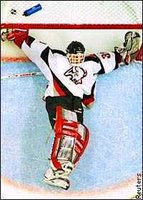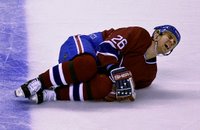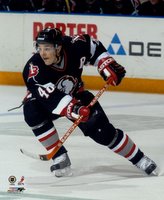The All Injury Line
High-risk, high-reward. That's the strategy I believe the Oilers should follow as they troll the free agent market and look for deals with teams close to the cap.
Most of the UFAs remaining on the market have readily forecastable performance, and apparently teams are willing to pay through the nose for it. But most of their performances are likely to be mediocre -- when Anson Carter is billed by the NHL as the biggest-scoring name out there, it's a thin market. Paying full price or over-price for middling production is no recipe for success.
But there remains a crop of players who, mainly due to injuries, are tough to project. It's not that they've failed to produce, it's that no one is sure how much of the season they'll play. Because this risk is priced into their deals, they're relatively cheap. And unlike prospects, you don't have to wait to find out if your decision's paid off.
Here then are the leading candidates I'd like to see the Oilers pursue. Out of this group, it should be possible to ice an all-injury third line that costs $5 - 7 million and is capable of scoring 90 goals in a full-season. And then, of course, there's that goalie Andy and I would like to see the Oilers sign...
 Dominic Hasek
Dominic Hasek2005 Salary: $1.5 M
2005 Injury: Groin. After re-injuring his groin on February 21st, Hasek missed the last 25 games of the regular season and the playoffs.
Performance: In 43 games, Hasek was second in the league in save percentage (.925) and goals against (2.09), posting a 28-10-4 record. Over the same number of games, Dwayne Roloson recorded a 14-24-5 record and a .908 save percentage. At a minimum, Hasek should be able to give the Oilers league-leading goaltending for half a season. It would be worth twice the price.
 Eric Lindros
Eric Lindros2005 Salary: $1.55 M
Position: C
2005 Injury: Torn wrist ligament. Lindros missed 27 games after injuring his wrist on December 12, then aggravated the injury after his return. He missed the last 22 games of the season and required surgery.
Performance: Lindros played less than 40 games in each of the last two seasons, but continued to produce at a fairly high level. His 11-11-22 line in 33 games last year is similar to his 10-22-32 in 39 games in the pre-lockout year. Last year's injury was, for once, not a product of his heads-down play. Had he chosen surgery when first injured, he might have returned earlier. Presumably a doctor's report and a strength/flexibility assessment could put the Oilers' minds at ease before inking a deal.
 Martin Rucinsky
Martin Rucinsky2005 Salary: $3 M
Position: LW
2005 Injuries: Knee and Finger. Rucinsky suffered through a nagging left-knee injury that cost him time from October to December and again in March, then he broke his left index finger on March 25th and missed the last 12 games of the season.
Performance: The 35 year-old former first-round pick (Oilers, 1991) went 16-39-55 in 52 games, with a +10 and 56 PIM. Given the knee injury, he's probably available at a significant discount to last year's salary.
 Eric Daze
Eric Daze2005 Salary: $2.28 M
Position: LW/RW
2005 Injury: Back. Daze played only one period during the 2005-06 season, and just 19 games in the 2003 season. Chicago coach Trent Yawney says the injury is serious enough that he doesn't expect Daze to come back -- to the team, or to hockey. I've no way to judge if that's true, but someone should be checking. If Daze can skate, he'd come very cheap to whichever team gave him a chance.
Trade Bait or Offer Sheet?
A few Group II players stand-out as candidates for acquisition through trade or offer sheets because of their recent injuries. These include:
 Daniel Briere: The 28-year-old Centre delivered 25-33-58 in 48 games before undergoing abdominal surgery for a hernia. The Sabres gave Briere a qualifying offer, but the young star is seeking a better deal than last year's $1.9 million contract and is going to arbitration. Buffalo is limiting itself to a small increase from last years's $29 million payroll. The Sabres' highest-paid player, Chris Drury, earns $3.15 million, and the club recently spent $5.8 million to sign Spacek and Numminen. Bottom line: Briere is priced to move.
Daniel Briere: The 28-year-old Centre delivered 25-33-58 in 48 games before undergoing abdominal surgery for a hernia. The Sabres gave Briere a qualifying offer, but the young star is seeking a better deal than last year's $1.9 million contract and is going to arbitration. Buffalo is limiting itself to a small increase from last years's $29 million payroll. The Sabres' highest-paid player, Chris Drury, earns $3.15 million, and the club recently spent $5.8 million to sign Spacek and Numminen. Bottom line: Briere is priced to move.- Ladislav Nagy: Double-knee surgeries ended the left-winger's season at 52 games. The 27 year-old earned just under $2 million while delivering 14-41-56 over 51 games. Phoenix GM Mike Barnett is trying to get a cut-rate from the player, saying that "Our only concern is whether we'll have this type of talent in our lineup for 80 games a year or 50 games." If the parties can't agree to terms on a three-year deal, Barnett will settle for a one-year contract followed by UFA status.
 Colby Armstrong: Synchronicity. Colby Cosh recently posted a shaky photo of Lloydminster's Canada Day fireworks; and now here I am recommending Lloydminster native Colby Armstrong. The 23-year-old is of course an RFA, and is compensated accordingly: $778,100 for putting up 16-24-40 (+15, 58 PIM) in 47 games. Do that as a 30-year-old, and you can pull in several million. In truth, Pittsburgh has no reason to trade its 2001 draft pick (his shoulder surgery is now safely in the past), but if the Oilers decide to enter into full rebuilding mode, this Colby would make a fine addition. Ditto Michel Ouellet, 24, Pittsburgh's promising right-winger, who missed about a dozen games last year scuffling through minor injuries. After bursting onto the scene with 10 goals in 10 games, he lost his scoring touch, but he's still learning the game.
Colby Armstrong: Synchronicity. Colby Cosh recently posted a shaky photo of Lloydminster's Canada Day fireworks; and now here I am recommending Lloydminster native Colby Armstrong. The 23-year-old is of course an RFA, and is compensated accordingly: $778,100 for putting up 16-24-40 (+15, 58 PIM) in 47 games. Do that as a 30-year-old, and you can pull in several million. In truth, Pittsburgh has no reason to trade its 2001 draft pick (his shoulder surgery is now safely in the past), but if the Oilers decide to enter into full rebuilding mode, this Colby would make a fine addition. Ditto Michel Ouellet, 24, Pittsburgh's promising right-winger, who missed about a dozen games last year scuffling through minor injuries. After bursting onto the scene with 10 goals in 10 games, he lost his scoring touch, but he's still learning the game.



2 Comments:
Sounds right to me...but maybe he could be driven by a Lindros, Briere, Horcoff or Stoll (well, maybe not Stoll).
It's all blue sky, but it makes sense to me as a way to construct a cheap third line with tons of potential.
It's the same as the college pitchers vs high school pitchers debate in baseball drafting. Take two of each, graph an idealized projection of their future production, and assume they have the same mean output. The college pitchers hug the mean on either side, while one of the two high school players is far below replacement-level (doesn't pan out) and the other is miles above (he's a star).
What's left in the UFA market are a bunch of mean-huggers -- or more accurately, a bunch of performers with minimal variability in their likely production.
To achieve higher potential production the Oilers need to embrace variability. The ones who washout can be replaced by call-ups at minimum wage.
[h/t to p.330 of BP's 2006 Guide for the simplicity of the comparison.]
Nice idea but that is exactly what the Leafs tried last year - in net with Belfour, up front with Lindros (concussions etc etc), Allison (concussion, slowest man alive) and O'Neill (fear of flying and alcoholic, I think).
True story, last autumn I was walking my newborn son down the Danforth. Walked by this unkempt, shambling fellow and thought, jeez, that hobo sure resembles Jeff O'Neill.
About a week later they're interviewing O'Neill about how he likes T.O. and he says he loves it, lives on the Danforth etc etc.
Ayhow, it turned into a disaster for the Leafs as you well know. They had little choice - they were in such a mess, capwise - and if it worked out JFJ would have looked like a genius.
But man, you have to be really lucky.
Post a Comment
<< Home